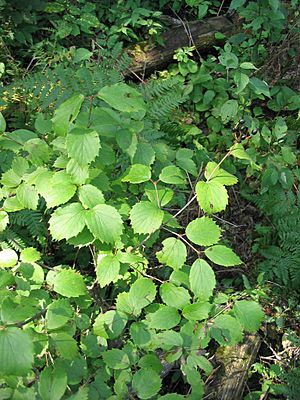Downy arrowwood facts for kids
Quick facts for kids Downy arrowwood |
|
|---|---|
 |
|
| Scientific classification | |
| Genus: |
Viburnum
|
| Species: |
rafinesqueanum
|
Viburnum rafinesqueanum, also known as the downy arrowwood, is a type of medium-sized shrub. It usually grows to about 2 meters (or about 6.5 feet) tall. This plant is native to many parts of Eastern North America, including the Eastern United States and Canada. You can find it from Quebec and Manitoba all the way south to Georgia and west to Oklahoma.
Contents
Discovering the Downy Arrowwood
What is Downy Arrowwood?
The downy arrowwood is a deciduous shrub. This means it loses its leaves in the fall and winter. It's a common plant in forests and along roadsides in its native areas. It's known for being quite tough and can grow in different types of soil.
Leaves, Flowers, and Fruit
The leaves of the downy arrowwood are special. They grow in pairs directly opposite each other on the stem. These leaves are simple, meaning each leaf has a single blade. In late fall, the leaves change color to a beautiful orange-red.
In the spring, the downy arrowwood produces many small flowers. These flowers are quite pretty to look at. However, if you get too close, they might have a slightly unusual smell. After the flowers fade, the plant grows dark blue fruits. These fruits are like small berries and are called drupes.
How to Spot It
Sometimes, it can be tricky to tell the downy arrowwood apart from other similar plants. For example, the southern arrow-wood (V. dentatum) looks a lot like it. But the southern arrow-wood blooms a bit later in the season. It also has wider leaves with more jagged edges and longer stems for its leaves.
Other plants that look similar include the smooth arrowwood (V. recognitum) and the Carolina arrowwood (V. carolinianum). Each of these has small differences that help experts tell them apart.

